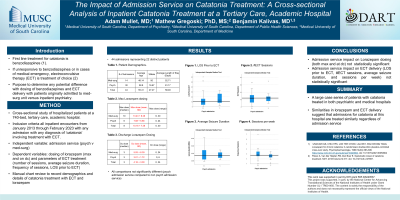Catatonia
Session: Poster Session
(009) The Impact of Admission Service Benzodiazepine Dosing and Receipt of Electroconvulsive Therapy: A Cross-sectional Analysis of Inpatient Catatonia Treatment at a Tertiary Care, Academic Hospital

Trainee Involvement: Yes
- AM
Adam Mullet, MD
Resident Psychiatrist
Medical University of South Carolina
Charleston, South Carolina, United States - MG
Mathew Gregoski, PhD
Research Assistant Professor
Medical University of South Carolina College of Medicine
Charleston, South Carolina, United States 
Benjamin Kalivas, MD
Assistant Professor of Medicine and Psychiatry
Medical University of South Carolina
Charleston, South Carolina, United States
Presenting Author(s)
Co-Author(s)
The Impact of Admission Service Benzodiazepine Dosing and Receipt of Electroconvulsive Therapy: A Cross-sectional Analysis of Inpatient Catatonia Treatment at a Tertiary Care, Academic Hospital Benzodiazepines are the first line treatment for catatonia (Ungvari, 1999). If unresponsive to benzodiazepines or in cases of medical emergency, electroconvulsive therapy (ECT) is treatment of choice (Pelzer, 2018). This study investigates potential differences of the dosing of benzodiazepines and use of ECT with patients originally admitted to medical or surgical service or inpatient psychiatric service. This study is a cross-sectional study of hospitalized patients at a 740-bed, tertiary care, academic hospital. The data set included all inpatient encounters from August 2018 through June 2022. Inclusion criteria was any patient admitted to our hospital during this time period with any diagnosis of ‘catatonia’. Primary outcomes were maximum dose of benzodiazepine received while inpatient and whether or not patience received ECT. The main independent variable was admission service. Sixty patients were included in the analysis. The average age of the patients included was 43 and 38% were male. Sixty percent of the patients were African American and 33% were white. Admissions with a diagnosis of catatonia were on average 33.73 days with care provided commonly both by primary psychiatric and non-psychiatric services (38 of 60 admissions were to psychiatric service). Both patients admitted to primary psychiatric service and patients admitted to non-psychiatric service had rates of receiving ECT of 35%. Median dose of maximum benzodiazepine dosing was 6mg. Median dose of maximum benzodiazepine dosing for patients admitted to inpatient psychiatric service was 6mg compared to 8mg on medical or surgical service. This difference was not statistically significant. This study represents a large case series of patients with catatonia treated in both psychiatric and medical hospitals. This study demonstrated no statistical difference of admission service on maximum benzodiazepine dosing or receipt of ECT for patients admitted for catatonia. Conclusion/Implications: The results of this study suggest that treatment by primary psychiatric service and psychiatric consult service was similar regardless of treatment setting. The patients in this study represent a diverse sample with regards to both sex and race. Therefore, the results of this study could be useful in understanding how to improve care for diverse communities. UNGVARI GS, CHIU HFK, LOK YEE CHOW, LAU BST, WAI KWONG TANG. Lorazepam for chronic catatonia: A randomized, double-blind, placebo-controlled cross-over study. Psychopharmacologia. 1999;142(4):393-398. https://www.ncbi.nlm.nih.gov/pubmed/10229064. doi: 10.1007/s002130050904 Pelzer A, Van Der Heijden FM, Den Boer E. Systematic review of catatonia treatment. NDT. 2018;Volume14:317. doi: 10.2147/ndt.s147897.
Background:
Methods:
Results:
Discussion:
References:

